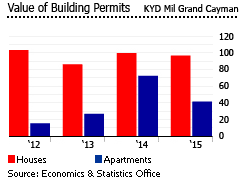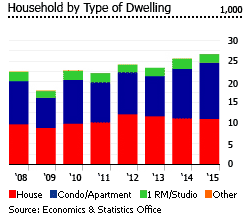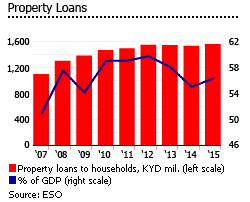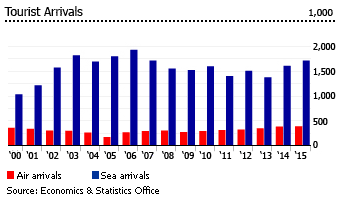Property prices are rising strongly in Cayman Islands
After several challenging years, Cayman Islands’ property market is now growing rapid again, amidst increased consumer and investor confidence. House prices are rising strongly. Property transactions are picking up. Residential property construction is also rising, though more slowly.
During the first seven months of 2016, the average value of freehold property transfers rose by 23.8% to KYD389,602(US$475,124) over the same period last year, based on figures from the Lands & Survey Department. The average value of freehold property transfers rose by 6.7% y-o-y last year, after a 9.5% decline in 2014.
Growth is centered along Seven Mile Beach for condominiums, and Cayman Kai, on the island’s north, for single-family homes. The most expensive housing are along Seven Mile Beach, a coral-sand beach located on the western end of Grand Cayman island, where property prices can reach as high as KYD1,066 (US$1,300) per square foot (sq. ft.).
- At ThePinnacle, a luxury beachfront development on Grand Cayman's Seven Mile Beach, the average sales price of condominium units was KDY1.68 million (US$2 million) in 2015, up by 11% from a year earlier, according to Charterland, Ltd.
- At The Meridian, a collection of 32 super luxurious oceanfront villas located on the Seven Mile Beach, the average sales price of villas was KDY1.41 million (US$1.68 million) in 2015, up by 12% from the previous year.
- At the Regal Beach Club, a beachfront condominium development of 57 units in six, 3-storey blocks located on the Seven Mile Beach, the average sales price rose by around 10% y-o-y to KYD522,694 (US$622,255).
- At the George Town Villas, a 54-unit seafront condominium development in Grand Cayman, sales prices also increased 13% in 2015 from two years ago.
- At The Grandview, a seafront development of 60 condo units in 12, three-storey blocks in Seven Mile Beach, the average sales price increased 8% y-o-y to KYD475,149 (US$565,654) in 2015.
Other areas are also experiencing robust growth. In George Town’s Garden, Coco, Mystic and Sunset Retreat, the average sales price of two-bedroom inland townhouses rose by 9% y-o-y to KYD193,591 (US$236,087) in 2015.

“We are seeing a definite uptick,” said Malin Ratcliffe of West Indies Brokers Real Estate. In fact, with strong demand, coupled with limited supply, the housing market is now turning into a seller’s market.
Property demand is rising strongly. The total number of open market property transfers in the Cayman Islands rose by 14.5% to 1,559 units in 2015 from the previous year, based on a property review conducted by Charterland, Ltd. Likewise, the value of real estate transactions also rose by 6.5% y-o-y to more than KYD536 million (US$653.7 million).
Residential construction activity is slowly improving, with an increase in luxury condominium developments. The total value of residential building approvals in Cayman Islands increased 3.8% y-o-y in 2015 to KYD268.2 million (US$327.1 million), according to Cayman Islands Planning Department. A sports and real estate development is planned on a 600-acre of land in the eastern district of Grand Cayman. The development is expected to include a world-class golf course and to offer freehold apartments, villas, and land plots starting from KYD205,000 (US$250,000).
During the past decade, the movement of the average value of property transfers has been erratic. This can be attributed to large-scale acquisitions made by some property developers in a particular period, which distort the property market. For an instance in 2011, Dart Group made significant acquisitions, which represented about 28% of the total value of all the property transfers for that year.
Positive housing market outlook
Caymans’ property market is expected to remain buoyant in the coming months, especially along Seven Mile Beach and in residential developments such as the Crystal Harbour, Grand Harbour, Vista Del Mar, and the Yacht Club, according to local real estate experts.
One of the newly developed luxury residential developments on Seven Mile Beach is The WaterColours residences, which is now selling rapidly. Dart, a luxurious, boutique-style commercial and residential LEED complex in Camana Bay is now finished and already available in the market.
“Currently, there are over 230 companies operating, with over 800 employees. As CEC continues to expand, supply undoubtedly will be impacted, with prices of properties possibly increasing,” said Charterland. With the Health City Cayman already fully operational, residential property in the surrounding area are also becoming more attractive to investors.
Property transactions are rising strongly

Property demand is surging. The total number of open market property transfers in the Cayman Islands rose by 14.5% to 1,559 units in 2015 from the previous year, based on a property review conducted by Charterland, Ltd. Likewise, the value of real estate transactions also rose by 6.5% y-o-y to more than KYD536 million (US$653.7 million).
Some of the highest value property sales recorded in 2015 include the following:
- Treasure Island Resort: sold for KYD12,031,433 (US$14,323,135) net of chattels
- Land parcels measuring 43 acres on the inland of South Sound Road: sold for KYD6,641,880 (US$7,907,000)
- Holiday Inn Resort (formerly Grand Caymanian Hotel): sold for KYD6,408,360 (US$7,629,000) net of chattels
- Stone Island, a development site measuring 7.3 acre located in the Yacht Club: sold for KYD5,905,200 (US$7,030,000)
- A unit at The Waters Edge development: highest price condominium sale at KYD5,718,827 (US$6,808,127)
From January to July 2016, total freehold property transfers increased 5.2% at 1,048 units compared to the same period last year, based on figures released by Cayman Islands’ Lands and Survey Department. Likewise, the value of freehold transfers skyrocketed by 30.3% y-o-y to KYD408.3 million (US$497.9 million) during the first seven months of 2016.
The surge in demand can be partly attributed to increasing interest from foreign investors. At least 75% of homebuyers in Cayman Islands come from the United States and Canada, said Malin Ratcliffe of West Indies Brokers Real Estate. There is also a growing interest from Europeans and South Americans.
Residential construction activity slowly recuperating

Residential construction activity is slowly improving, thanks to an increase in luxury condominium developments. The total value of residential building approvals in Cayman Islands increased 3.8% y-o-y in 2015 to KYD268.2 million (US$327.1 million), according to Cayman Islands Planning Department. Building approvals for condominiums increased 15.2% y-o-y to KYD152.7 million (US$186.2 million), thanks to a luxury condominium development in George Town and condominiums in the North Sound area. However, this was partially offset by an 8.2% decline in building approvals for houses.
In Grand Cayman, residential building permits fell by 19.7% in 2015 from a year earlier, according to Cayman Islands Planning Department.
- The total value of building permits for houses in Grand Cayman dropped 3.1% y-o-y to KYD96.5 million (US$117.7 million) in 2015 from a year earlier
- The value of permits for apartments in Grand Cayman plunged 42.5% y-o-y to KYD41.6 million (US$50.7 million) over the same period.
The rise of canal-front properties

Recently, there has been increased interest in canal-front homes, both from home buyers and property developers, according to Re/Max Cayman Islands, mainly because they are a more affordable alternative to oceanfront properties but also offer incredible views to home owners.
For an instance, canal-front homes are currently under construction along the Seven Mile Beach corridor, stretching up to West Bay, primarily on land south of the Ritz-Carlton, Grand Cayman, and land to the north of the Yacht Club and land at Camana Bay. Another example is that of Safe Haven, though the canal-front properties there are leasehold.
By end-2015, there were 20 canal residential subdivisions in Grand Cayman, half of which can be found along the Seven Mile Beach and West Bay, and the other half run east from Prospect to North Sound Estates and the Cays in Rum Point.
Canal subdivisions can be divided into five levels, depending on the price and quality.
- Level 1 – the most expensive and top of the line estate homes, with strong covenants and manned security gates. These include Vista Del Mar, Salt Creek, and Camana Bay, with land values ranging from KYD451,000 (US$550,000) to KYD2,460,000 (US$3,000,000).
- Level 2 – luxury homes with strong covenants but unmanned security gates. These include canal-front developments such as the Crystal Harbour, Crystal Cove, Cypress Pointe North, Britannia, and the redeveloped Cayman Islands Yacht Club, with land values ranging from KYD303,400 (US$370,000) to KYD820,000 (US$1,000,000).
- Level 3 – well-maintained upper-middle class luxury homes with good covenants. These include developments such as the Canal Point, the Shores and Mangrove Point, the Grand Harbour, the older and more developed side called South Reach, The Isles, The Estates, Patrick’s Island, and Sunrise Landing, with land prices ranging from KYD246,000 (US$300,000) to KYD492,000 (US$600,000).
- Level 4 – mixed mid-level homes with decent services, including older subdivisions like Red Bay, Omega, and Prospect and newer developments such as Newlands Sound, Palm Heights in Snug Harbour. Land values range from KYD123,000 (US$150,000) to KYD295,200 (US$360,000).
- Level 5 – mid- to low-level homes with minimal maintenance, such as the North Sound Estates and Red Bay Prospect. Land values range from KYD102,500 (US$125,000) to KYD164,000 (US$200,000).
Mortgage interest rates gently rising

Mortgage interest rates in the Cayman Islands are typically tied to the prime rate set by the Cayman Islands Monetary Authority (CIMA), which follows the US Fed funds rate. Typically, mortgage interest rates are one or two percentage points above the current prime rate. The Cayman Islands dollar (CI$) is pegged to the US dollar at CI$1 = US$1.20.
During the first quarter of 2016, the average prime lending rate was raised by 25 basis points to 3.5%. Prior to the rate hike, the prime lending rate has been at 3.25% since Q1 2009, based on figures from the CIMA. Likewise, the average interest rate on loans has risen to 7.18% in Q1 2016, from 6.96% in the previous quarter and 7.18% from a year ago.
The maximum loan-to-value (LTV) ratio is 70% of the property’s appraised value, with maximum term of around 10 to 15 years. However, Caymanians are offered longer periods of between 30 to 40 years. The minimum loan amount is US$100,000.

Cayman Islands’ mortgage market has grown rapidly in the previous years, from just about 30% of GDP in 2003 to around 60% of GDP in 2012. However, the mortgage market contracted to 58.1% of GDP in 2013 and to 55% of GDP in 2014. Last year, the size of the mortgage market grew slightly to 56.2% of GDP.
In 2015, the total outstanding amount of property loans to households increased slightly by 1.9% y-o-y to KYD1.55 billion (US$1.89 billion), according to the CIMA.
In Q1 2016, foreclosure rate dropped to 1.5%, from 2% in a year earlier.
The rental market is growing
The Cayman Islands’ rental market is expanding as the population rises, and more employees have offices in the island’s special economic zone, Cayman Enterprise City. In 2015, almost 48% of households in Cayman Islands rented their dwellings, up from 46% in the previous year, according to the Economics and Statistics Office.
The rental market is tight, especially near Seven Mile Beach in Grand Cayman, which is considered as the most expensive area in the Cayman Islands, according to Capital Realty. A two and three-bedroom condominium unit on Seven Mile Beach rents for about KDY2,050 (US$2,500) to KDY4,510 (US$5,500) per month.
Apartment complexes on Seven Mile Beach offering long-term rentals include George Town Villas, The Grandview, Sunset Cove, Seagull Condominiums, Laguna del Mar, Lacovia, The Sovereign and The Pinnacle. Currently, monthly rents range from KYD2,000 (US$2,439) to KYD9,000 (US$10,976).
The Terraces, located in the Camana Bay, also offers 63 apartments for long-term rental, with monthly rents starting from KYD2,050 (US$2,500) for a one-bedroom unit.
There are also other upscale residential areas outside Seven Mile Beach. This includes the South Sound, a posh area close to schools, and George Town which offers executive homes and apartments. The monthly rent of two-bedroom apartments across the road starts at KYD1,500 (USD1,829) while those on the sea are rented from KYD2,000 (USD2,439) to KYD4,600 (USD5,610).
In the Old Crewe Road, the Sunrise Apartments, Pine Crest Apartments and Elizabeth Villas are found, with the monthly rent of two-bedroom apartments starting from KYD1,400 (US$1,707). Some of the newer, more exclusive condominiums in the area are rented out from KYD2,000 (US$2,439) to KYD2,500 (US$3,049) per month.
Other areas in Cayman Islands popular with families and professionals include Jennifer Drive, Andrew Drive, Palm Heights Drive, Canal Point Drive, Parkway Drive and Whitehall Estates.
Cayman Islands also offer good rental yields, ranging from 5%-7% along the Seven Mile Beach to 7.5%-8.2% in other beach communities in Grand Cayman, based on a research conducted by Global Property Guide.
Tourism getting stronger
Tourist visits from the United States, Canada and Europe are rising. Tourism accounts for around 30% of GDP. In 2015, the total number of visitor arrivals rose by 5.5% y-o-y to around 2.1 million, according to the Cayman Islands’ Department of Tourism.
- Stay-over visitors increased slightly by 0.7% y-o-y to 385,400 people in 2015.
- Sea and cruise ship arrivals also increased by 6.7% to 1,716,800 people in 2015 from a year earlier.
During the first eight months of 2016, air arrivals rose slightly by 0.5% to 281,770 tourists from the same period last year. Over the same period, cruise arrivals increased 5.9% to 1,189,963 tourists. The United States accounted for around 75% of all tourist arrivals in Cayman Islands.

The introduction of medical tourism in the country is a new strand. The Narayana Cayman University Medical Center, a 500-acre, 2,000-bed medical school and hospital complex - opened its first phase, a 200-bed hospital, in August 2012. According to its renowned heart surgeon, Dr. Devi Shetty, the hospital initially intended to target medical tourists from America, but will also focus on attracting patients from South and Latin America and the Caribbean.
To attract more visitors, the government has been improving its infrastructure and flight access from around the world. Recently, the government has unveiled its plan to construct an airport terminal, with an estimated cost of US$50 million. The expansion of the Own Roberts International Airport is expected to be completed by 2018.
According to Kim Lund of RE/MAX Cayman Islands, other significant developments include:
- George Town port and berthing facility for cruise ships;
- Camana Bay town centre expansion and residential development of 200 homes and condominiums;
- Expansion of Marriot Courtyard Hotel and its re-instatement to a new 4 to 5 star brand;
- Cayman Enterprise City and special economic zone;
- Construction of exclusive properties such as the Kimpton Hotel and the Ironwood developments, which are expected to be on the market by 2016; and
- The Hyatt Hotel, which was destroyed by Hurricane Ivan in September 2004, was also recently announced to undergo a major renovation these coming months.
Modest economic growth

The Cayman Islands is one of the most affluent countries in the Caribbean. Thanks to its twin pillars of development, tourism and international finance, this British overseas territory enjoyed average real GDP growth of 3.1% annually from 1998 to 2007. The country is the world’s sixth largest banking center. “Cayman is a First World country in the Caribbean with a large international business community and well developed, diverse facilities including hospitals, schools, golf courses and hotels,” says Charles Weston-Baker of Savills.
From 2008 to 2010, the spillover effects of the global financial meltdown caused real GDP to fall by 7% in 2009 and another 2.7% in 2010. The economy finally recovered in 2011, with a real GDP growth rate of 1.2%. However, the economic growth has been modest since then. In 2015, the economy grew by 2%, after expanding by 2.4% in 2014, 1.5% in 2013, and 1.2% in 2012, according to the Economics and Statistics Office (ESO). The economy is expected to continue growing modestly this year.
In 2015, consumer prices fell by 2.3% from a year earlier, after inflation rates of 1.3% in 2014, 2.2% in 2013, and 1.2% in 2012, according to the ESO. Then in June 2016, consumer prices dropped 0.8% from the same period last year.
Unemployment is currently 3.9%, down from 4.2% in 2015, 4.6% in 2014, 6.3% in 2013, 6.2% in 2012, and 6.3% in 2011, according to the ESO.